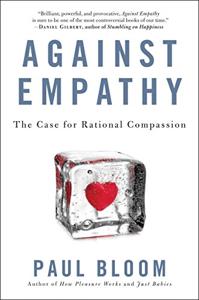
Want to learn the ideas in Against Empathy better than ever? Read the world’s #1 book summary of Against Empathy by Paul Bloom here.
Read a brief 1-Page Summary or watch video summaries curated by our expert team. Note: this book guide is not affiliated with or endorsed by the publisher or author, and we always encourage you to purchase and read the full book.
Video Summaries of Against Empathy
We’ve scoured the Internet for the very best videos on Against Empathy, from high-quality videos summaries to interviews or commentary by Paul Bloom.
1-Page Summary of Against Empathy
Overview
It seems like there are a lot of tragic events happening all over the world. If you’re honest with yourself, you might feel more grief for some victims than others. This is why it’s not a good idea to rely on empathy alone when trying to relate to people who have been affected by these tragedies.
If you want to see more compassion in the world, don’t blame a lack of empathy. Instead, look at the biases that make people show more sympathy for some tragedies than others. You’ll learn about mirrors neurons, which help us learn faster and why Make-A-Wish Foundation isn’t always the best charity.
Big Idea #1: Empathy is an emotional response that allows us to understand and feel what others go through.
Empathy is an important emotional resource. It’s often talked about in conversations, usually referring to someone who could use more of it. But what exactly does empathy mean?
Empathy is a way of understanding and sharing the feelings of another person.
To see empathy in action, we can look at the aftermath of a tragedy like the massacre at Sandy Hook Elementary School. On December 14, 2012, gunman Adam Lanza killed 20 children and six adults.
The author’s wife felt the need to visit their children’s school after hearing about a shooting at another school.
The author went to a coffee shop later that day and saw people weeping. The woman was crying, but she didn’t know any of the victims or the shooter, so it seemed like an overreaction.
President Obama shared his sympathies about the tragedy in public.
When people are able to put themselves in the shoes of others, they feel what their friends and family members feel. This is a great example of emotional empathy. Cognitive empathy refers to understanding someone’s feelings without feeling them yourself.
Unlike emotional empathy, cognitive empathy is used by con artists and bullies to understand a victim’s weakness and exploit it.
Emotional empathy can also be physical. For example, you might see someone fall and hit their head and then feel pain in the same spot where they hurt themselves. Similarly, John Updike described feeling a tightness in his throat whenever his grandmother had one of her “choking fits” at dinner.
Big Idea #2: Empathy is a popular topic today; it can be fostered through experience.
There’s been a lot of interest in empathy recently. You can see this by looking at the books about it on the shelves of bookstores around America.
There are numerous books, conferences and self-help gurus devoted to the subject of empathy. The Internet is full of videos and articles about how to be more empathetic. It seems like there’s nothing that can’t be solved with a little bit of empathy.
The author observed conferences and online communities where empathy was seen as a way to improve both your private and work life, as well as a viable cure for the world’s problems. During 2014 there was growing unrest in America after multiple cases of young black citizens being killed by police officers. The author looked into this problem to find out if either side lacked empathy or both sides were lacking it.
This story teaches us that we shouldn’t focus on one person and ignore the other. We must see things through both perspectives in order to come up with a solution that benefits everyone.
If empathy is balanced with compassion, it will have a positive effect. For example, if parents have a child with special needs, they’ll feel more empathy and compassion for all people with special needs.
If we don’t, people will continue to be selfish and uncaring towards others. Parents should teach their kids empathy by asking them questions like “How would you feel if someone treated you that way?”





